
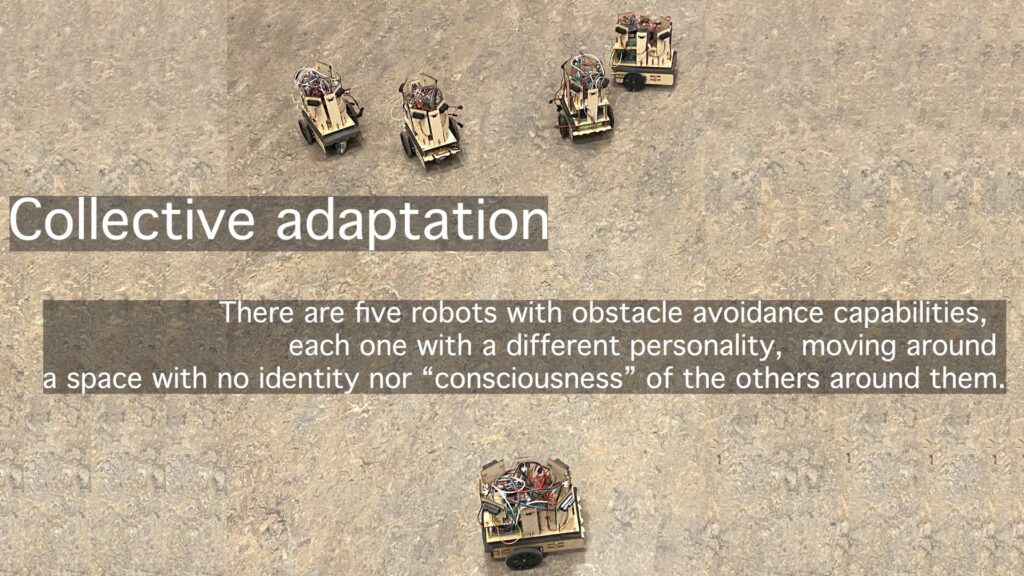
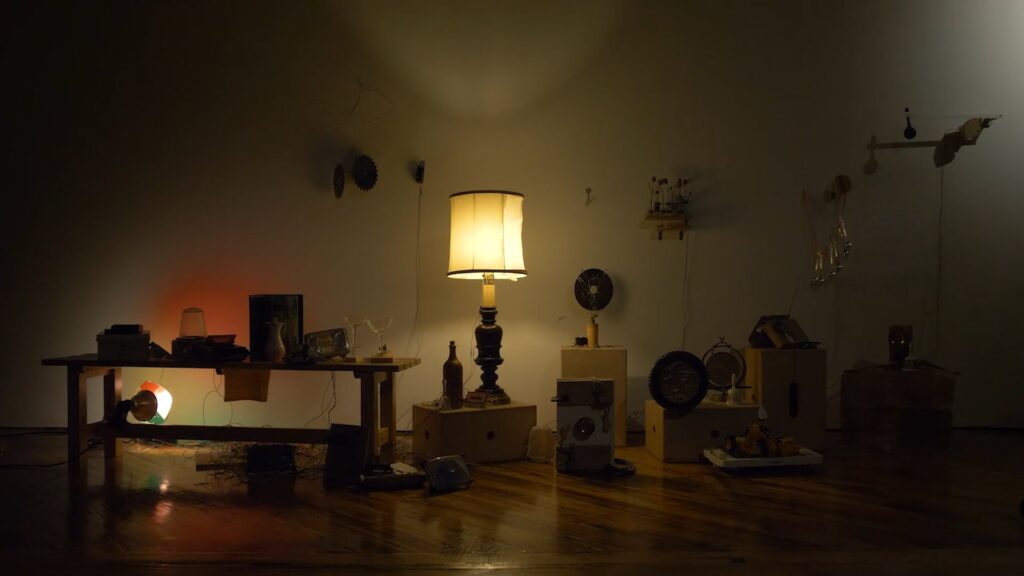
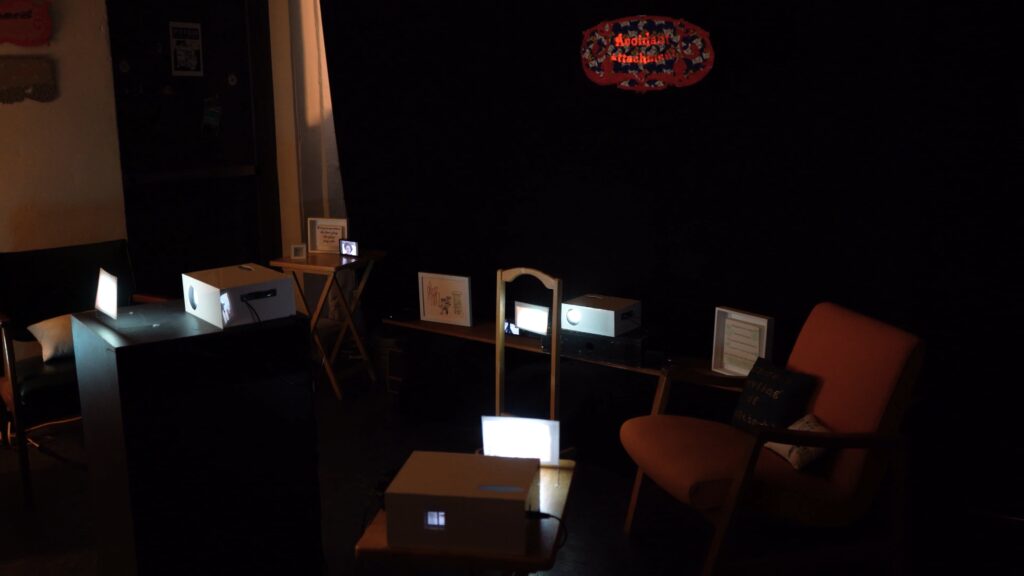

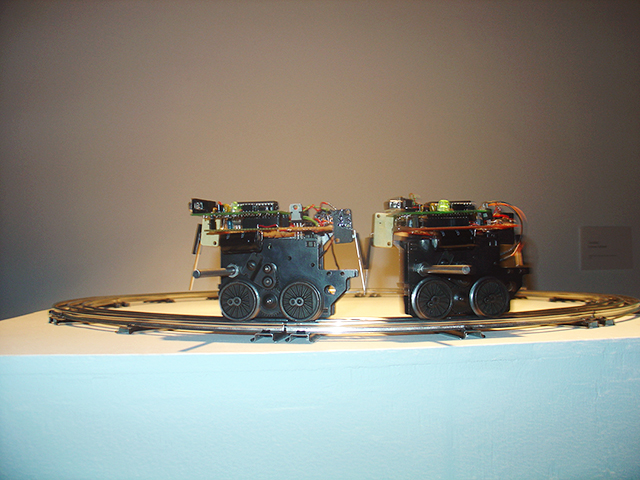
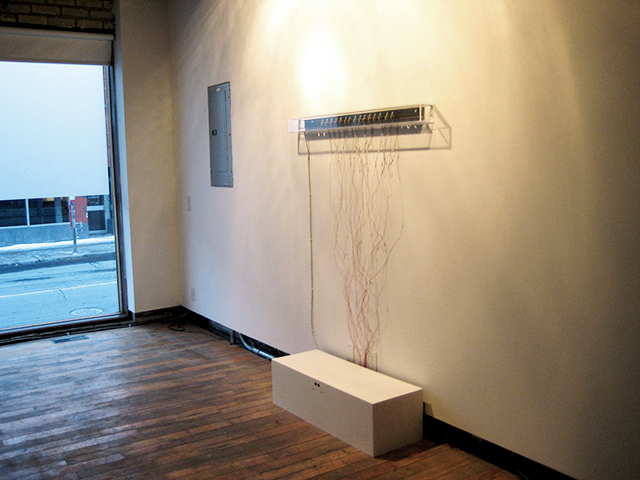
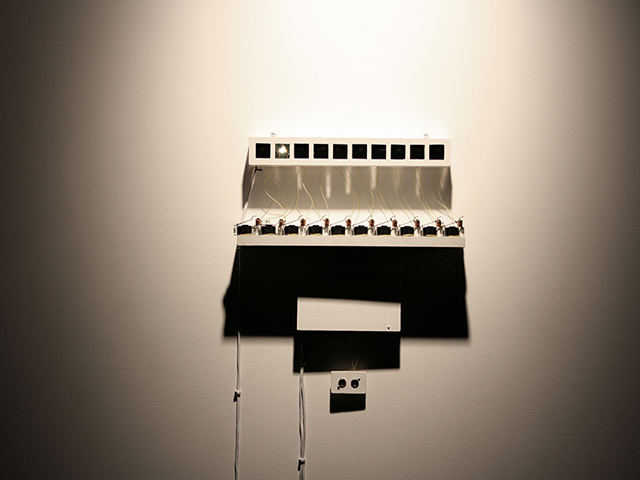
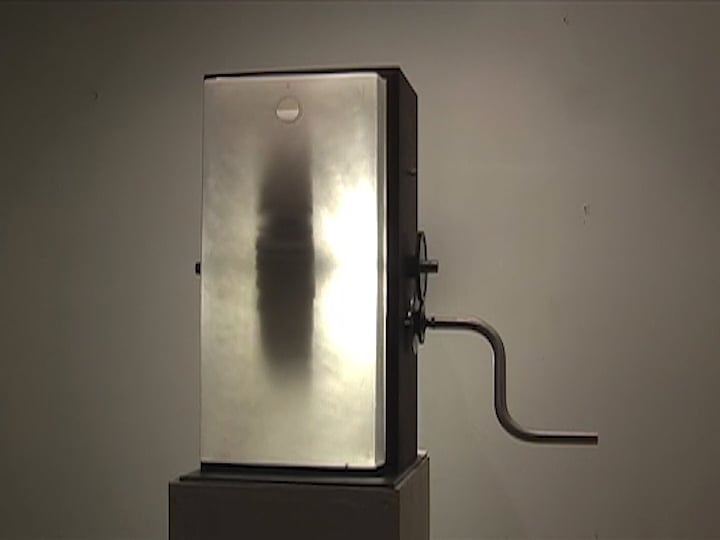







Sonando te sueño
Provisional Documentation.
An electromechanical composition where its “sonic and visual machines” are made from found objects, family keepsakes, and items associated with a past time and place. In February 2020, I took part in an artist residency in Toronto, Canada. During the residency, as a thematic gesture of shared collecting, I invited visitors to bring cherished objects that held emotional value and a history of migratory movement to become part of a cumulative installation. The fundamental aim of Sonando te sueño is to create a meeting point for stories of migration and memories of times and places, and to imagine a digital way of generating an aesthetics of movement.
This work was updated for exhibition at Artsenal Inoxis, Alhaurín el Grande, Málaga, Spain – June 2025.
Collective adaptation
Collective Adaptation is a swarm robotics installation consisting of five autonomous robots inspired by the collective behavior of social insects such as termites, ants, and bees. Each robot possesses identical physical capabilities but distinct behavioral personalities—the Explorer, the Elusive, the Wanderer, the Candid, and the Impulsive. Equipped with distance sensors and location-based technology, the robots navigate space with awareness of their neighbors and react to obstacles or others according to their personality. This system explores themes of sameness, otherness, and the concept of the outlier—those data points that fall outside the curve in machine learning and AI systems, frequently discarded as errors or exceptions. The work establishes parallels between the emergence of complex behaviors in natural and robotic swarms with self-organized social movements from the Global South such as #NiUnaMenos and the Marea Verde, questioning how algorithms and society treat difference. Each robot represents the value of the outlier within networked systems, challenging the notion that diversity must be eliminated in favor of uniformity, and celebrating how individual agents with unique characteristics unite through shared purpose to create transformative change.
The Objects that we carry
An electromechanical composition where its “sounds and visual machines” are made of found objects, family memorabilia and objects associated with a former time and place. This project started in 2012. During February 2020, Lorena was part of a Traversal Residency at Trinity Square Video, in conjunction with Public Visualization Lab. As a thematic gesture of shared collecting, during the residency Salomé encouraged visitors to bring treasured objects that hold emotional value and a movement story to be part of an accumulative installation. The fundamental objective of The Objects That We Carry is to create a rendezvous for stories of migration and memories of times and places, and to imagine a digital means of generating an aesthetic of movement. With the support of Canada Council for the Arts
Self-portrait in Parts
Presented as a narrative divided into segments, this (work in progress) of the video installation combines visuals and ambient sounds captured from everyday life using a mini DV camera and phones. Texts extracted from the artist’s personal diary complement the imagery, creating a multi-sensory experience. The videos span the years 2003 to 2021, encapsulating a transformative period in Lorena’s life—marked by profound changes such as emigrating to Canada and the passing of Salomé’s father. This installation serves as a fragmented self-portrait, a reconstruction of the artist’s internal daydreams and a journey through her psyche. The space invites active participation, allowing viewers to stroll through and construct their interpretation of the unfolding narrative. Utilizing videos predating the era of social media, the navigation through the space mimics scrolling through someone else’s life, blurring the boundaries between the private and public realms. As we traverse the installation, we find ourselves interwoven into the artist’s world and intimate reflections.
Closeness
The piece consists of two balls made of tissue paper, bike spokes and a robot. They inhabit the same space, divided in two parts, and they move around very slowly. A robot is moving a ball that has spokes attached to it and another layer of tissue paper on top of the spokes. The entities have IR sensors that help them define their perimeter of allocated space and they move randomly within the specified area. There is violence surrounding the piece that builds up through time. The objects’ movements are slow and their appearance is non-threatening but, when they get close to one another, they damage each other, bringing the possibility of total destruction. As time passes by and the balls interact, the dynamic of exchange is such that it progressively tears down the outer shell of tissue paper leaving open the inner structure with the spokes exposed. At this moment in time, our perception of the piece changes. The two entities transform in something different. They degenerate. The end result of their interaction is unpredictable. The two pieces may move separately or they can get entangled. Once entangled, the drive for random independent movement can result in mutually destructive behavior. They are two autonomous entities without any control from the artist or the viewers.
Untitled (trains)
There are two objects moving on a circular track. They move independently from each other in a codependent manner and they live within rules created for a group of two. These rules have been programmed into the vehicles so they can interfere, hit, follow and escape each other. Whenever they hit, each one has 8 choices – forward with 4 different speeds and backward with 4 different speeds. The result of their interactions cannot be predicted.
With model trains, we create a contained, miniature world that is controllable. However, in this piece, I have hacked the trains and they no longer function as originally intended. We cannot control them; their behaviour goes beyond our control. They generate unpredictable behaviours and, consequently, an unpredictable system where a new and different kind of order can emerge.
Untitled (solenoids)
The piece consists of 15 objects that repeat a pattern over and over. They move in groups and interact with the others building a conversation.
The 15 objects are rotary solenoids that are programmed to turn on and off making the sounds that we, as participants of the piece, hear. They are connected to a microcontroller that has a code that creates a pattern for them to follow.At the same time, as we move around the room, we hear two layers of sounds. One is the sound of the solenoids themselves and the other one is the digitized sound of the solenoids. The second one is easily recognized as modifiable. As we walk around the room, new sounds are digitally generated. There is the possibility that we realize that our movements are generating a change. A microphone is capturing the sounds that the 15 solenoids produce and sending the information to PD.
PD receives two flows of information: the sound from the mic, and data from an ultrasonic sensor located in the room. Therefore, when the participant moves around the room, PD changes the output pitch of the sounds that the solenoids produce. This change gives us the illusion that we can transform things around us. We are responsible of alterations in our surroundings. The question is if those changes can alter the pattern to be constantly creating new ones. In untitled (solenoids)-v2 the pattern changes through time, as long as there are people interacting with the piece. The changes are produced depending on the amount of times that the sensor is triggered. So, the more people that interact with the piece, the more the pattern of the solenoids change. We are participating in the production of a system that is in constant change.
A conversation
A conversation is an interactive piece. There are 10 solenoids producing sounds and creating a composition between images and sounds. Each solenoid is coupled to a light. When the solenoid turns on, it makes a mechanical sound and it correspondent light turns on, making visible the image attached to it. But, when the viewer/participant gets next to the piece, the experienced scenery breaks down. Its dimensions are very small so invites for closeness. The viewer/ participant wants to get close to the piece in order to be able to view the images that turn on and off in composition with the sounds that the solenoids are generating. However, the participant attempt of being part of this private world always fails.
Although there is the possibility to get near it, it is a piece that can’t be looked at from very close. The lights and sounds stop and all the participant can see are solenoids that don’t work and ten small black squares where the images can’t be distinguished. The viewer/participant becomes an intruder of an intimate world that is created by this group of solenoids, images and lights. The images that are shown in this piece are a sequence of the artist having a conversation with an unknown person in a private setting. It is a work that is asking for a distance and, because of the nature of the pictures, we can think that is not only the artwork that is asking for a distance but the artist as well.
Skipping
Skipping is a mechanical device based on mutoscopes, one of the earliest mechanisms to generate motion in images. These devices were coin-operated and were used at fairs and carnivals.
This work plays with the idea of the Peeping Tom, the one who looks where it is uncertain whether they are allowed to look.
Sin título (brazos)
In this interactive piece, two exact objects try to complete a circular motion. Only one can complete the circle on behalf of the other’s failure. When the participant triggers the sensor, one object hits the other in order to accomplish its purpose. The other sees every attempt blocked.
The participant is responsible of making the objects move. Therefore, its interaction with the piece generates violence.